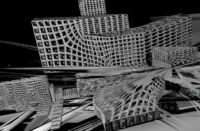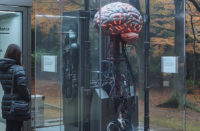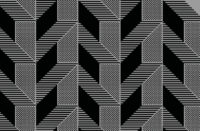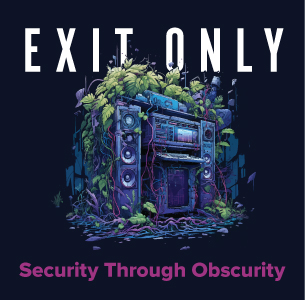
>>> Key
::..:::…..:..::….:::::..:::..:::::::……:::…::.:::….::::..:..:::…::…….::::
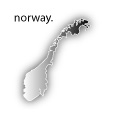 :: Deathprod (Helge Sten + co.) circa 1991-2001, ten years, four CD’s, all in stylish black. OK, I am not writing a commercial – just the lead-in to an overall epic collection of dark musing, austerely brooding, mind-noodling music from the genetically fertile grounds of Norway. Sten, once a member of indie-out jazz experimenters Supersilent, has kept tasking the mostly unreadable Deathprod project for over a decade. Here, in what would seem like an ultimate collection that delves into those many years, are four complete discs packed with an inebriating cranial fix that will keep you holed up for a while. Play this in its entirety, guaranteed to wear you thinner than any work out routine. It goes something like this….
:: Deathprod (Helge Sten + co.) circa 1991-2001, ten years, four CD’s, all in stylish black. OK, I am not writing a commercial – just the lead-in to an overall epic collection of dark musing, austerely brooding, mind-noodling music from the genetically fertile grounds of Norway. Sten, once a member of indie-out jazz experimenters Supersilent, has kept tasking the mostly unreadable Deathprod project for over a decade. Here, in what would seem like an ultimate collection that delves into those many years, are four complete discs packed with an inebriating cranial fix that will keep you holed up for a while. Play this in its entirety, guaranteed to wear you thinner than any work out routine. It goes something like this….
The latest release by Deathprod is packaged in this set, as well as available separately. Starting with the suspended drone of “Tron” it’s like looking infinitely east over the Pacific Ocean. This also serves as the soundtrack to a low point earthquake while high atop a towering building. The vague reverberation rumbles like a baby pea in your gut, you feel a break in the equilibrium of the moment, like an organic déjà vu. “Dead People’s Things” is a maudlin piece of thrilling cinema. Hauntingly mythical like a voyeuristic exploration in the plight of witnessing a decaying animal corpse behind the safety of a giant repelling windscreen, a nightmarish life after death experience. The growl of “Cloudchamber” is familiar, the aching wrath of an angry storm about to powerfully let go. Brilliantly stocky bass rides the curse of the clouds. Invisible at first, the raw (naked) eye of this storm are steered by Ole Henrik Moe’s seduction of the saw alongside Sten’s “audio virus.” The two kick up a bulky dust equivalent to something pretty real-time, live sounding. Winds inflict the shape of thin air and roar in and out of the shallow depth of field offered on “Morals and Dogma.” The higher power canvassed cautiously is a deity of many guises, one who can shade the whitest ray of light, and absorb its entire prismatic energy.
On this unreleased disc of rare tracks “Reference Frequencies #3” initially places us on the sidelines of a speedway. The whiz of dramatic superlight zings by the way one of those Matthew Barney “Cremaster” films did. On “6:15” a poet (Matt Burt?) is caught speaking of lovers, public transit and baby goop. The illusion of speaking of colors and domesticity reasons with this artists’ realities. His speech, somewhat stunted, contends with change of time, anti-depression meds and Nintendo. As he continues with his freeverse a smokey space theme plays as a steady backdrop, drifting, fleeting. At first I cringed with a big cheesy smile when the Hammond organ reared its suburban mall flanks on “Recording the Jürg Mager Trio: La Luna” but with the additional vibes, this “wake” is beyond the cheekiness of the Munsters. When Magnus Ryan takes hold of the organ and Bent Saether’s drumming is added the whole thing turns to a 60s drug-induced séance. This “shortcut to the stars” could be the playing of distant cousins of the Doors in their more acidic frame of mind. A broken Ferris wheel spins a half crescent as caged felines rage. As these reference frequencies continue radio waves sizzle and mutate, harmonic convergence is within reach, but there still remains a violent knot somewhere deeply embedded in the pit of its stomach. The utter despair poised by Moe’s strangulated strings on “Dora 3” leave you wanting. Although the breath has left the sails by the end you may feel a bit wind-blown by the full excursion.
Recorded live in Oslo (1996), this long-deleted recording is like the second coming to all those who love experimental film soundtracks all originally recorded to phonograph cylinder. Emulating the romanticism of an old-fashioned creaky film projector, and the percussion of a garbage drummer on tin, “Imaginary Songs From Tristan Da Cunha” combines the right amount of noir with its more grounded aesthetics. Throughout “Stony Beach” and “Boatharbour Bay” filtered violin, thanks to Ole Henrik Moe subdues the mind holistically, bowing out of sight but right outside the inner ear and frontal lobe. The closing half hour in which a choir of seven play glass to Deathprod’s unearthly deconstruction of the theremin’s whim. Voices as spirits, drift like poltergeists in pained softhearted chant while Moe’s strings rip through the belly of this ship. These imaginary songs are like waking up in a Victorian dream, with winds blowing large lace curtains, people rushing in hallways in staggered motionlessness, like a broken film reel (a continued theme). The grave is open, spirits rising, freedom for the undead. Pretty spooky stuff.
From the start, the orchestral procession on this long absent 1994 recording is akin to the mystical illusory feeling one gets from witnessing the films of Peter Greenaway. Hans Magnus Ryan’s violin is gut wrenchingly passionate. The live “Treetop Drive 1-3” come in repetitive, stretched out feedback tones that are aching for action, it’s like a turning point you relive over and over. The phrasing changes to remove the bow’s chalky edge, leaving a trebly drone that mellows with time. “You are getting sleepy,” Part 2 sounds like an air raid at sea, as if they contact mic’d one of the metal buzzers a wee too closer, the dialogue between the ‘warning’ and the bass release, in itself is like a trippy backlog of memory jogging, a blunt force brainwash. And so it goes for it near ten-minute stretch. Cryptically repellent. By the time Deathprod reached the final segment in this trio of treetops things have sedated to a whirring, filtered turntable lockgroove. The mumbly tone careens and remains pretty low to earth. Its flat appeal is a welcome gesture after the barrage of doldrums and discordant preface, even with the added voice samples discussing a pedestrian perception of the desensitization of death. The atmosphere is a locked cell where you can only perceive the flames of a lost city being fanned but cannot see a thing. With the dynamic existential playing by Sten, Magnus Ryan and Edvard Grieg, only a sixth sense drives the imagination. The eighteen-minute “Tugboat” docks perilously in a harbor of ambiguity. A lone captainless craft just teetering, communication systems down, with the slightest rumble of primeval risk in the scent of night.
::..:::…..:..::….:::::..:::..:::::::……:::…::.:::….::::..:..:::…::…….::::
*FINLAND :: Welcome to an adventure. Fifty-nine year old Pekka Airaksinen has been recording since the 1960’s and “Madam I’m Adam” is more of a homage to his endurance than a new recording. Though these two discs include tracks Airaksinen has recorded between 1968 and 2002, giving any first-timers a full flavor for the longevity of a brilliant light on the horizon of electronic music over these four decades. Also included is an entire disc of previously unreleased mixes by some really outstanding (and unusual) composers. 1974’s “Molybdene” comes from his pseudonym project Gandhi – Freud which originally was released on his “Vitamin” recording. It’s like a hustle-bustle sound illustration of one of Mondrian’s works. The tinny field of textural levels built and bent on “Pieni sienikonsertto – A Little Soup for Piano and Orchestra op 46,8” is out there with the twang seasick allure of an industrial groundbreaking. A city is built as a man experiments with its cyclic resonance, gears, poles, all unearthed. Under the name Ajraxin his latest work keeps current with beats that are perpetual, and somehow not dulling or same-old. In fact, the guise of “No focus” from his 2002 “Hole in the Soul” CDR, is subtle enough to be background music, but beat-conscious enough to make its mysterious orchestration a bit of a necessary closer listen.
From his 1983 recording “Jewel Comet” the upright jazz drumming vs. Indian vibe of “”Suvarnabhasgarbha” is a bit of a lonely dog that has walked into a room full of Theremin’s at full prong. No animals or ancient electronics were harmed during this experiment (I think). His performance-art troupe The Sperm’s “Shh!” dates back to 1968 (originally on O Records and re-released on CD-R in 1998 by Dharmakustannus). Surreal capsule of sound thought with voice transmission samples and mind-obliterating organ drone – this pre-dated even early Scanner by a good few decades. From Ajraxin’s 2002 “Datta” recording, the composer loops cinematic warning signs, and other encoded electronic beats, TILT! There is a tiny bit o’ disco sampled. “Mykkä peili” is a livewire that just rips and zaps like of heated electrical current swiftly channeling through the veins of a major corporate networking system. The Sperm’s unreleased “Organ” is fully erect in this late 60’s barrage of party noise and voice (Mattijuhani Koponen). The guttural guitar is an outpouring of sonic angst for a Helsinki that would never be the same.
The remixes are true transformations of the originals, a companion disc that rolls, reels and just flies off the page. With artists who are downright strikingly offbeat whose aural stimulation may bring its listener to a point of exhaustion. Included here are a healthy roster from Anton Nikkila and Simon Wickham-Smith to Philipp Quehenberger, Curd Duca and Mira Calix. The surprising and fluidly serendipitous inclusion of Steven Stapleton’s Nurse with Wound caps off this set as a must in your hybrid collection of true sound art. The mixes are more enhancements, strays, and manipulations. But as Men without Hats once said “you can dance if you want to!” They also said, “you can leave your friends behind.” Ahem. This is a rarity of sound exploration, a look at a man who has been at it for nearly four decades –Pure, uncompromising, filthy artfulness.
::..:::…..:..::….:::::..:::..:::::::……:::…::.:::….::::..:..:::…::…….::::
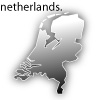 :: Made for installation, A Magic Square of 5 to Look at… is like a digital organ in and out of consciousness. Poland’s Septegenarian multimedia artist Paul Panhuysen who has been making sound art since the evolution of Fluxus in the 60s treats our ears to something virtual, something transfigured. Time-based sound structures made for an audience to interact, grids of sound and objects that deal in Hz rather than in thin air, the work deals with subtle frequency tonalities. What turns out like sounds from a spy thriller but in actuality are complex geometries that fill space and time. Squares dissected by numerals and letters and measurements all based on a software program – makes parts of “The Matrix” that much more realistic. This 1/2 hour piece has an inebriating effect, drawn-out passages that contain high altitudes and warmer bass drone making you imagine being at the edge of a large-scale vista somewhere in the Australian Outback.
:: Made for installation, A Magic Square of 5 to Look at… is like a digital organ in and out of consciousness. Poland’s Septegenarian multimedia artist Paul Panhuysen who has been making sound art since the evolution of Fluxus in the 60s treats our ears to something virtual, something transfigured. Time-based sound structures made for an audience to interact, grids of sound and objects that deal in Hz rather than in thin air, the work deals with subtle frequency tonalities. What turns out like sounds from a spy thriller but in actuality are complex geometries that fill space and time. Squares dissected by numerals and letters and measurements all based on a software program – makes parts of “The Matrix” that much more realistic. This 1/2 hour piece has an inebriating effect, drawn-out passages that contain high altitudes and warmer bass drone making you imagine being at the edge of a large-scale vista somewhere in the Australian Outback.
::..:::…..:..::….:::::..:::..:::::::……:::…::.:::….::::..:..:::…::…….::::
 :: What would happen if you married Enigma and Sisters of Mercy and gave them all chainsaws instead of silver rattles? Yea, des Esseintes ain’t no trust fund baby! This split CD includes two enormously large sounding Swedish electro-gothic acts taking on some new territory. Their single track “Scrying/Closure” sounds like the theme from one of those two-season mini dramas on Fox, with a crowd of grunting gladiators, a mosque full of chanting men and a beat to boot. Not a quick read, and not my favorite sound in the world. Diskrepant takes a slightly different tact on “Variety Unknown” which incorporates a devilish vocal erasure with a varying hardline take on music concrete. The all to short to assess “Grand Mal” comes and goes unobtrusively and is followed by the barrage of feedback that is “..and the machines laughed at mankind.” I like the Metropolis-istic premise of this noisy, jilted rampage, but, ahem! A sudden loop of silence leads to a repeating futuristic Nasa-style voice checking the system interface and body chemistry. And back into the fire of metallic wreckage and glitch-core galore. This is a difficult listening experience no matter how they slice it.
:: What would happen if you married Enigma and Sisters of Mercy and gave them all chainsaws instead of silver rattles? Yea, des Esseintes ain’t no trust fund baby! This split CD includes two enormously large sounding Swedish electro-gothic acts taking on some new territory. Their single track “Scrying/Closure” sounds like the theme from one of those two-season mini dramas on Fox, with a crowd of grunting gladiators, a mosque full of chanting men and a beat to boot. Not a quick read, and not my favorite sound in the world. Diskrepant takes a slightly different tact on “Variety Unknown” which incorporates a devilish vocal erasure with a varying hardline take on music concrete. The all to short to assess “Grand Mal” comes and goes unobtrusively and is followed by the barrage of feedback that is “..and the machines laughed at mankind.” I like the Metropolis-istic premise of this noisy, jilted rampage, but, ahem! A sudden loop of silence leads to a repeating futuristic Nasa-style voice checking the system interface and body chemistry. And back into the fire of metallic wreckage and glitch-core galore. This is a difficult listening experience no matter how they slice it.
::..:::…..:..::….:::::..:::..:::::::……:::…::.:::….::::..:..:::…::…….::::
 :: This is among the top most mind numbingly ethereal recordings I have ever heard in my life, ranking high up there with Nurse With Wound’s ‘Soliloquy for Lilith’. The ambient drone is something born out of hyperventilation and cascading emptiness. Jgrzinich’s Intimations are personal dark entries into the wondrous crossing between vapory industrial sound and delicate field recordings with experimental piano. His past work has included duo recordings with peer acousticians Seth Nehil and MNortham. The hushed ambience of these sounds is actually quite piercing, with just a paranormal presence, only a permeable sense of realism, providing a textural aura –Mute crackle, wispy crunch, still crumble. The track “Sun in Hand, Stone in Water” has a menacing circular tone that curls like chronic vertigo. Oblique mist that snakes as the disc closes with an organic leak of water that sounds as if it is falling atop a glass piano, causing a fountain.
:: This is among the top most mind numbingly ethereal recordings I have ever heard in my life, ranking high up there with Nurse With Wound’s ‘Soliloquy for Lilith’. The ambient drone is something born out of hyperventilation and cascading emptiness. Jgrzinich’s Intimations are personal dark entries into the wondrous crossing between vapory industrial sound and delicate field recordings with experimental piano. His past work has included duo recordings with peer acousticians Seth Nehil and MNortham. The hushed ambience of these sounds is actually quite piercing, with just a paranormal presence, only a permeable sense of realism, providing a textural aura –Mute crackle, wispy crunch, still crumble. The track “Sun in Hand, Stone in Water” has a menacing circular tone that curls like chronic vertigo. Oblique mist that snakes as the disc closes with an organic leak of water that sounds as if it is falling atop a glass piano, causing a fountain.
::..:::…..:..::….:::::..:::..:::::::……:::…::.:::….::::..:..:::…::…….::::
 :: Dirk Dresselhaus takes the ball and runs with it. Here he remixes (er “Reconfigures”) works by several interesting co-conspirators in the electronica realm. His reshaping of Aesthetics collective pulse programming takes their “Suck or Run” from the very influential “Tulsa for One Second” and creates a completely new track where he’s retrofitted his own “hippyshit” vocal duties. Margo’s “Take Me” also appeared on her “catnaprmx – Peter I’m Flying” record. His attraction to the vocoder bleeds and blends her sultry vocal and incorporates some burpy synthetics that are retro-tasty. The previously unreleased mix of Lamb’s “Wonder” appeared originally on their “Between Darkness and Wonder” record that came out last year.
:: Dirk Dresselhaus takes the ball and runs with it. Here he remixes (er “Reconfigures”) works by several interesting co-conspirators in the electronica realm. His reshaping of Aesthetics collective pulse programming takes their “Suck or Run” from the very influential “Tulsa for One Second” and creates a completely new track where he’s retrofitted his own “hippyshit” vocal duties. Margo’s “Take Me” also appeared on her “catnaprmx – Peter I’m Flying” record. His attraction to the vocoder bleeds and blends her sultry vocal and incorporates some burpy synthetics that are retro-tasty. The previously unreleased mix of Lamb’s “Wonder” appeared originally on their “Between Darkness and Wonder” record that came out last year.
The Schneider TM treatment cradles the Zeena Parkins-styled harp melodies serving them like delicacies, Lou Robinson’s vocal is adorned by soft scraping percussion and reverse beats. The standout cut is the grungy Prince funk-encrypted “Ephe Kicks In, Feel Like Kevin” that has TM working with Mille Plateaux duo Rechenzentrum alongside Kpt Michigan and furthermore featuring Marc Marcovic. This steals the show with its “Flashdance” era drum beat and tweaky vocal that gives T.Raumschmiere a run for his antics – thanks for the staticalicious ending! Bang, boom, sis, boom, bah! The Faint’s “The Conductor (The Tractor Mix)” slips, falls, gets back up again in its rubbery and staccato vocoderific play on Todd Baechle’s fantastic singing instrument. Ruby’s “Grace – Space Mix” is a nod to James Brown, delish. I feel it – “butter, runnin’ over me.” This one is on target and got its groove on, you will too –it reminds me of the vibe in some chewing gum commercial I recently saw starring this cool guy with a big ole fro.
The mix of Lampchop’s “The New Cobweb Summer (Lanzarote Remix)” recalls some early Lloyd Cole, Kurt Wagner’s vocal and percussion often in sync. The sax mellows things with the languid flow of hushed backing coos – though this is far more Salsoul Orchestra than your average chill out room. Hailing from Tours France, Alc Levora’s “Noitare Def Cinos” is defined as a space race, a mad dash, with just the right elements of plink and bleep to keep it from meandering off the page, the final 30 seconds, where it comes undone, is the best part. Dresselhaus’ own “Switched on Boss Hog” click-cuts its way through tall urban grassy patches, while using samples from Boss Hog’s “Whiteout” CD. Also included are tracks by Turtle Bay Club, Philip Boa & the Voodoo Club and Turner (Keni Mok) – all worth checking out. Sometimes I like Schneider TM better as a mixer than a solo performer. He knows how to run the show, takes a separatist approach to the way sounds get broken down, minimalized and then funked up. A far cry from 1999’s infamous debut, “Moist” as Dresselhaus has simply upped-the ante on humor and his overall pop stance.
::..:::…..:..::….:::::..:::..:::::::……:::…::.:::….::::..:..:::…::…….::::
 :: Mike Paradinas comes out of hiding with a massive double disc of new material. OK, I am one of those people who didn’t really get the whole µ-ziq phase – but I know I am in the vast minority. Though, as dopey as the new moniker sounds Kid Spatula has bright promise, and takes to task that whole 80s retro sound that has flip-flopped for all those eurotrash proto-Danceteria wannabe go-goa’holics. Only because “I’ve been there and have done that” can I make a valid sneer as the new guard who just recycle rather than build from the essence of foregone brilliance. Well, get your recipe books out, because this Spatula is whipping up a funny mock-up of all that and more.
:: Mike Paradinas comes out of hiding with a massive double disc of new material. OK, I am one of those people who didn’t really get the whole µ-ziq phase – but I know I am in the vast minority. Though, as dopey as the new moniker sounds Kid Spatula has bright promise, and takes to task that whole 80s retro sound that has flip-flopped for all those eurotrash proto-Danceteria wannabe go-goa’holics. Only because “I’ve been there and have done that” can I make a valid sneer as the new guard who just recycle rather than build from the essence of foregone brilliance. Well, get your recipe books out, because this Spatula is whipping up a funny mock-up of all that and more.
After digging into his discography a bit I noticed electro-impresario Paradinas has amassed over 17 recordings in just a bit over a decade, pretty impressive. These recordings were dedicated to DAT somewhere between ’94 and ’98 (noticing that he recorded under this moniker for 1995’s Spatual Freak (Reflective). Though, this alter-persona includes bubbly, vivacious beats, toy synths, spoken samples, meandering spy-thriller themes, and catchy 80s riffs aplenty. Just take “Spacious Hallway” for instance – it sounds like he’s crossed the accordion of an Italian street musician with the strings of the Brodsky Quartet, but managed to make the illogical references remain non-academic, and quite hilarious, without intentional puns. He still references the road-runner styling of flip jungle percussion (“Further 2”) with its beyond beat box fat lips, but this is added for effect, and does not drive this vehicle – which is refreshing. “Tugboat” brings on da funk, and some eyebrow curling Jean-Michel Jarre meets John Foxx lapsing sequencers that are about to hurl.
The Gameboy intro to “Carrier” leads you into the pop crackle of an Indian chanteuse rephrasing the same line over dancing jazz brass and mixed drum claps. “It starts with bongos” does –and adds what may be the outtakes tracks from “The Love Boat” theme. This one is g-ROOVY! Someone snap it up and mix it sidewards, please. These tracks are like little themes, all quite visual and ripe for video. While a majority of the material on Meast is heartily uptempo, the ambient, simple vibe on “Bobby” proves the man can chill – I would love to hear a full release of this type of material. It’s intricate minor beats are all rubberized and edgeless, and the patterned rhythm just glides like melted butter on a raw skillet.
Flipping to disc two the drum-centric percussion of “Sub & Solid” fuses into a caged clown pop-off beat that is hilarious repartee. The mood shifts and chills and cracks again to this cartoonish chicken speak. “Upton” starts of in shades of bluish gray and turns into a mock new age piece that is lighter fare recalling some of the now blush-worthy tones used by Flock of Seagulls and Kajagoogoo to name a few. Every jumbo-sized record has its share of filler and “Lesque” is one of those tracks which seems to be searching for a place while it rambles on but its got no funk, no beat, no thrill – trying to catch up in its final minute to no avail. The title track is a fun electro ride, playing on mid 80s guitar signature lines and the cheap thrills of drum pads. Though, this juicy lil’tidbit doesn’t pull too far from the driveway, it is rendered with a fashionable sense of love incarnate. Yeah – I admit, Paradinas makes fun of what he is parodying though with a sense that he really appreciates his influences, even their misses. This is a hefty batch of 34 tracks that may keep you guessing what did I have for lunch yesterday – though this man lives to eat, not vice versa.
::..:::…..:..::….:::::..:::..:::::::……:::…::.:::….::::..:..:::…::…….::::
 :: Take Medeski, Martin & Wood, mix a spoonful of 70s Sly Stone and whoop it up Y2K style and there it is. Damon Locks vocal has the bass dialect of John Foxx with a slight ragga edge. Other members of this Chicago-based trio include Wayne Montana and Tim Mulvenna, and among them they have played with Trenchmouth, the genius Vandermark 5, Peter Brotzman and a host of other jazz and rock n rollers. The keys are key here, slapstick funky rhythms with fly attitude, and just all full speed ahead, no hurdles, just out spirit. ‘Rawar Style’ is the group’s second full-length recording full of ska life (‘Space Dancehall’) where they reflect the era of both the Specials and B-52’s respectively. The kookie samplers and effects are cheesy-catchy and pumped full of gushing playfulness. The Eternals sound is sunny side up. Rawar Style has a certain timeless something, like being home again, but you’ve heard it long ago – though you couldn’t have, with its hip-hop flippancy minus the bling of golden fillings and tangled spandex thongs. One odd turn is the curiously off-putting Fiddler on the Roof phrasing that takes place on the otherwise tropical “Bewareness.” Listeners will be totally into the typewriter-on-speed beat that kicks off “This Here is Megaside.” But things change and derange in a jazzy pout of unconsciousness, a sort of underdressed male version of Chicks on Speed. The chant stops and poses like Peaches, but is half as creamy and nowhere as full frontal – but its illogical rants are pretty infections and not at all corny like the former can be perceived. The Beastie Boys slack is pulled up from behind on the wavering organ of the “Emperor’s New Break” – keeping the spirit of “On the Street” alive, miles and miles after the original embossed itself permanently in our pavement. Hit it boys!
:: Take Medeski, Martin & Wood, mix a spoonful of 70s Sly Stone and whoop it up Y2K style and there it is. Damon Locks vocal has the bass dialect of John Foxx with a slight ragga edge. Other members of this Chicago-based trio include Wayne Montana and Tim Mulvenna, and among them they have played with Trenchmouth, the genius Vandermark 5, Peter Brotzman and a host of other jazz and rock n rollers. The keys are key here, slapstick funky rhythms with fly attitude, and just all full speed ahead, no hurdles, just out spirit. ‘Rawar Style’ is the group’s second full-length recording full of ska life (‘Space Dancehall’) where they reflect the era of both the Specials and B-52’s respectively. The kookie samplers and effects are cheesy-catchy and pumped full of gushing playfulness. The Eternals sound is sunny side up. Rawar Style has a certain timeless something, like being home again, but you’ve heard it long ago – though you couldn’t have, with its hip-hop flippancy minus the bling of golden fillings and tangled spandex thongs. One odd turn is the curiously off-putting Fiddler on the Roof phrasing that takes place on the otherwise tropical “Bewareness.” Listeners will be totally into the typewriter-on-speed beat that kicks off “This Here is Megaside.” But things change and derange in a jazzy pout of unconsciousness, a sort of underdressed male version of Chicks on Speed. The chant stops and poses like Peaches, but is half as creamy and nowhere as full frontal – but its illogical rants are pretty infections and not at all corny like the former can be perceived. The Beastie Boys slack is pulled up from behind on the wavering organ of the “Emperor’s New Break” – keeping the spirit of “On the Street” alive, miles and miles after the original embossed itself permanently in our pavement. Hit it boys!
::..:::…..:..::….:::::..:::..:::::::……:::…::.:::….::::..:..:::…::…….::::
 :: Bass clarinet (compliments of Burkhard Kunkel) never had it this good. Ekkehard Ehlers uses software and technology to shift and shape the gutteral, wooden sounds and with that erects a full-on symphonic work with a 1″ thick laptop. “Politik braucht keinen Feind” is nothing if not simply desperate, dry, organic and downright depressing at first. In high contrast to its cover and poster art images of clubkids, the tone is distinctly morose and stern. “Mander” is a pure pastiche of light with various play on gravity. Pale and forensic, this experiment shifts through doldrums to re-appear as a restless opus of imbalance and hypnotherapy. “Blind” on the other side of the mind, is multifaceted, four-part piece the strings up Anka Hirsch’s cello by its inside out. Call it stringed sci-fi, for sure the psychedelic effects will in turn bow the mind backwards. Eerie delirium. Reminds me somehow of the inverse of similar investigations taken on by say Albert Ayler or outtakes of Grant Green, just add water (and acid)! Ehlers paints the fictionalized night in shifting monotonal grays. Finally, the sinuous “Woolfe Phrase” descends. Used by the Frankfurt Ballet, this queasy, uneasy wash of melodic undertone drifts slowly, slowly, empathically from its invisible edges. “Politik braucht keinen Feind” in the end plays like a tragic soap opera, without the garish one-liners and turgid acting – this one is more of a torch song, a heartfelt drama with multiple personas, meandering in and out of the story when you least expect. The work is confrontational without being in your face, emotionally charged and tight lipped in its real startling conclusion – its caress is to smooth, and also a bit didactic to slip on its icy surfaces.
:: Bass clarinet (compliments of Burkhard Kunkel) never had it this good. Ekkehard Ehlers uses software and technology to shift and shape the gutteral, wooden sounds and with that erects a full-on symphonic work with a 1″ thick laptop. “Politik braucht keinen Feind” is nothing if not simply desperate, dry, organic and downright depressing at first. In high contrast to its cover and poster art images of clubkids, the tone is distinctly morose and stern. “Mander” is a pure pastiche of light with various play on gravity. Pale and forensic, this experiment shifts through doldrums to re-appear as a restless opus of imbalance and hypnotherapy. “Blind” on the other side of the mind, is multifaceted, four-part piece the strings up Anka Hirsch’s cello by its inside out. Call it stringed sci-fi, for sure the psychedelic effects will in turn bow the mind backwards. Eerie delirium. Reminds me somehow of the inverse of similar investigations taken on by say Albert Ayler or outtakes of Grant Green, just add water (and acid)! Ehlers paints the fictionalized night in shifting monotonal grays. Finally, the sinuous “Woolfe Phrase” descends. Used by the Frankfurt Ballet, this queasy, uneasy wash of melodic undertone drifts slowly, slowly, empathically from its invisible edges. “Politik braucht keinen Feind” in the end plays like a tragic soap opera, without the garish one-liners and turgid acting – this one is more of a torch song, a heartfelt drama with multiple personas, meandering in and out of the story when you least expect. The work is confrontational without being in your face, emotionally charged and tight lipped in its real startling conclusion – its caress is to smooth, and also a bit didactic to slip on its icy surfaces.
::..:::…..:..::….:::::..:::..:::::::……:::…::.:::….::::..:..:::…::…….::::
 :: Zen static. Here we have Sir Sonic-Boom (Spacemen 3, Spectrum) establishing a giant remix (53 minutes worth) of, I am unsure what exactly, but I like what I hear. It’s as if he mic’d one of those toy plastic tubes that you spin around and they make this whirring noise. Havin seen E.A.R. perform a few years back in Spitalfields, I haven’t heard much new material since then, but Exposition Stylus Re-Mixed makes up for some lost miles in between. Not your traditional “remix” per se, this takes off with luminescent hum from the start and settles in mid air with a host of spacey sequencers, modulators and foreign speak (mutated Japanese). At times it sounds like a cranking engine in a lake, with an abridged fan belt, various rusty seat springs and a dirge to the lost souls of Atlantis. But Boom is an adventurous deep-sea diver herein as he’s not afraid to wiggle through the darker depths to uncover stones and other furtive crawlers way down under. By incorporating a vibrating drone that builds, backs-up, and just soaks through the whole span of sound space, “Exposition Stylus” illustrates themes of defiant exploration. This begs for a collaborative project with Andrew Lagowski as the two travel similarly to forbidden environments via their furtive (un)conscious. The woman’s voice, which appears and is obscured a few times throughout sounds if she is struggling to have the word “zero” pronounced correctly and thus conferring a message, a code, to the listener. The sounds become dense, faded, grayer and somewhat molted before our ears, tweaking our focal point to offbeat 60s sci-fi themed plutonium space junk sounds that just gravitate, and reshape themselves like bright fallout, and then dissipate, re-emerging as teeny-tiny pixels, and drift off without a trace. Warnings are set off to deter further entry by unknown predators and other alien beings. This whole pattern repeats, but shifts with a combination of multiple tremors and variable throbs. Dr. Who makes a house call.
:: Zen static. Here we have Sir Sonic-Boom (Spacemen 3, Spectrum) establishing a giant remix (53 minutes worth) of, I am unsure what exactly, but I like what I hear. It’s as if he mic’d one of those toy plastic tubes that you spin around and they make this whirring noise. Havin seen E.A.R. perform a few years back in Spitalfields, I haven’t heard much new material since then, but Exposition Stylus Re-Mixed makes up for some lost miles in between. Not your traditional “remix” per se, this takes off with luminescent hum from the start and settles in mid air with a host of spacey sequencers, modulators and foreign speak (mutated Japanese). At times it sounds like a cranking engine in a lake, with an abridged fan belt, various rusty seat springs and a dirge to the lost souls of Atlantis. But Boom is an adventurous deep-sea diver herein as he’s not afraid to wiggle through the darker depths to uncover stones and other furtive crawlers way down under. By incorporating a vibrating drone that builds, backs-up, and just soaks through the whole span of sound space, “Exposition Stylus” illustrates themes of defiant exploration. This begs for a collaborative project with Andrew Lagowski as the two travel similarly to forbidden environments via their furtive (un)conscious. The woman’s voice, which appears and is obscured a few times throughout sounds if she is struggling to have the word “zero” pronounced correctly and thus conferring a message, a code, to the listener. The sounds become dense, faded, grayer and somewhat molted before our ears, tweaking our focal point to offbeat 60s sci-fi themed plutonium space junk sounds that just gravitate, and reshape themselves like bright fallout, and then dissipate, re-emerging as teeny-tiny pixels, and drift off without a trace. Warnings are set off to deter further entry by unknown predators and other alien beings. This whole pattern repeats, but shifts with a combination of multiple tremors and variable throbs. Dr. Who makes a house call.
::..:::…..:..::….:::::..:::..:::::::……:::…::.:::….::::..:..:::…::…….::::
*FINLAND :: This is a collection of work by composers and presenters at 2003’s Avanto Festival in Helsinki. Things kick-off with Curd Duca’s “Excerpt from the soundtrack of The Subversion Agency” which combines an authoritative voice discussing a corporate hire(?), vinyl crackle, a heavenly cooing woman and a car starting. It’s a bit of a false start, an illusory preface. Thrill Jockey trio Radian’s edit of “NAHFELD” uses a radical tonal scale and some contorted marble-like percussion. Their sound graduates into a sonic reverberating bliss of would be jazz-funk drumming that frequently punctuates itself with the edge of guitar feedback straying slightly.
Mira Calix (Warp) sprouts a seed of “Belonging” on a track that uses vivid vibes that sound like an advanced child playing intuitively. Fluttering percussion and some raw half moans and understated growling add to the puzzling double-speak drowned in lovely harmonics. “Spridda park” plays with flashback theory, ala the film Memento, reverse mix and depth of field just constantly readjusting focus. It’s Pekka Airaksinen, making the visualization a bit unnerving, like a funhouse ride mocking you as you stare into the funny mirrors and garish faded colors. The vast approaches to sound as art, sound as experimental, are vast on “Avantoscore 2003” (I am only feeling left out that I did not attend). Newcomer, Bosnia’s Ibrahim Terzic, creates a wetscape on his boldly weird “Kvarni” a cut-n-paste piano meets sound effects meets tape rewind and a whole lot more kinda piece. Like so many others in thie vein, this is so playfully interesting you hardly have time to be trapped by its structure or technical aspects. Welcome back KK Null in a live portion of his revved up “Kosmik Engine.” Null is the world’s foremost living noise genius. To see him live is to experience something of live metamorphic pageantry. No glittery costumes, no combat boots (not even long hair, anymore). This man performs delicate procedures on sublimely vast caverns of fluorescent noise and sculpts it to pulp and then filters it back into something structured and compositional that correlates back into its original pod state, collapsing your breathing consciousness. Back to back with the Carpenters-esque “Muzak Decoding/Dream Machine/Pirates” piece by FM Einheit/Jon Caffery/Alexander v. Borsig the shift makes for a great polar pairing. The 1992 work uses a collapsing easy listening track with an overly amped water torture drip, seemingly easing into portions of this three-parter. A distant flying machine and dark ambient tonalities deconstruct the mix. Kari Peitsamo’s spoken word “cover “of “Rock ‘n’ Roll Will Never Die” parodies the ultimate adages of music supremacy by using a radio announcer on one end and a Japanese ESL wannabee on the other.
Leif Elggren’s addition, a detail of “My Mother’s Hair” is a heavy breathing dragon of a field recording or is it? His visual installation and other hybrid sound work make this something of an oddity in his continuous development. More like the unwanted anonymous caller on the other end of the line than an homage to something as abundantly textural as that which tops our skulls, it seems that I am missing some wires here. On the cheeky symphonic “Soon I Will Be Free” the unparalleled post-post Terre Thaemlitz (Comatonse, Mille Plateaux) rips the ass out of “grammy award winning” Chris Cross’ creepy permanent testament to the dangers of AOR by melting the vinyl, knowing that no one in their right mind would ever want to download that piece of histrionic toilet paper. Sometime member of the Helsinki Computer Orchestra, academic and well shaven Simon Wickham-Smith’s “Kivi-ihmisten laulu” is the unjarring of 100% pure ether filtered through a rough-cut cloth and then brought to the boiling point. If you have ever seen an indoor circus, this has the aura of its prelude. He plays with electronic fire starters here, but it’s just a small spark and play with light. “Once Upon a time in Berlin” is Geert-Jan Prins playing as his colossally fanciful German speaking from a Presidential address by his project “Staalplaat Soundsystem.” He uses a romantic public speech by Kennedy with an encoded set of staccato ordered industro-beats and ailing backdrop of Disney salon-styled orchestral animation. The duo of Ultra-red and Kanak Attak’s “Ghetto Express rmx” furthers the politico dialogue (as the collective are righteously known for). Asking for the right to be recognized, legalized, under oppression. The simple context of streaming the spoken two-way dialogue with the bouncy sandpaper feedback makes for a thematic document that speaks to those who better understand BPM than BBC. Pan Sonic’s Mika Vainio has the final word on “End Theme” taken from a film called A Monument for the Invisible. Its stunted life and supernatural timbre floats in and out rather quickly and effortlessly. It’s above our heads, through our senses, only perceptible, but not visible. The language of sound is the language of these distinct senses, illusory and raw –A provocative compilation.
::..:::…..:..::….:::::..:::..:::::::……:::…::.:::….::::..:..:::…::…….::::
Essential Links ::
::..:::…..:..::….:::::..:::..:::::::……:::…::.:::….::::..:..:::…::…….::::
Read more Microview’s ::
::..:::…..:..::….:::::..:::..:::::::……:::…::.:::….::::..:..:::…::…….::::
*Note :: Graphic for this country not available at time of publication.






